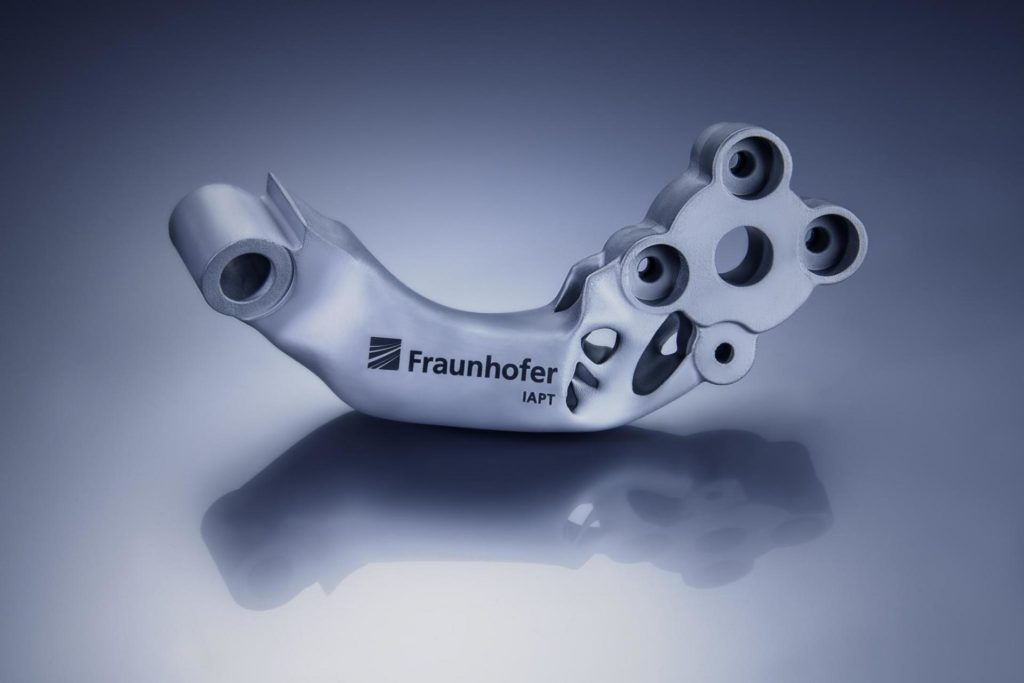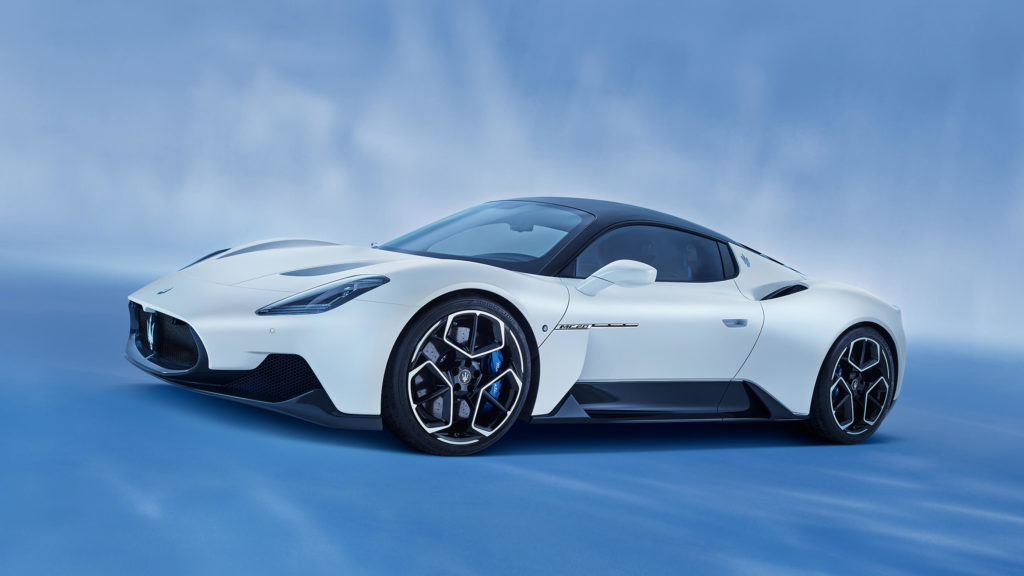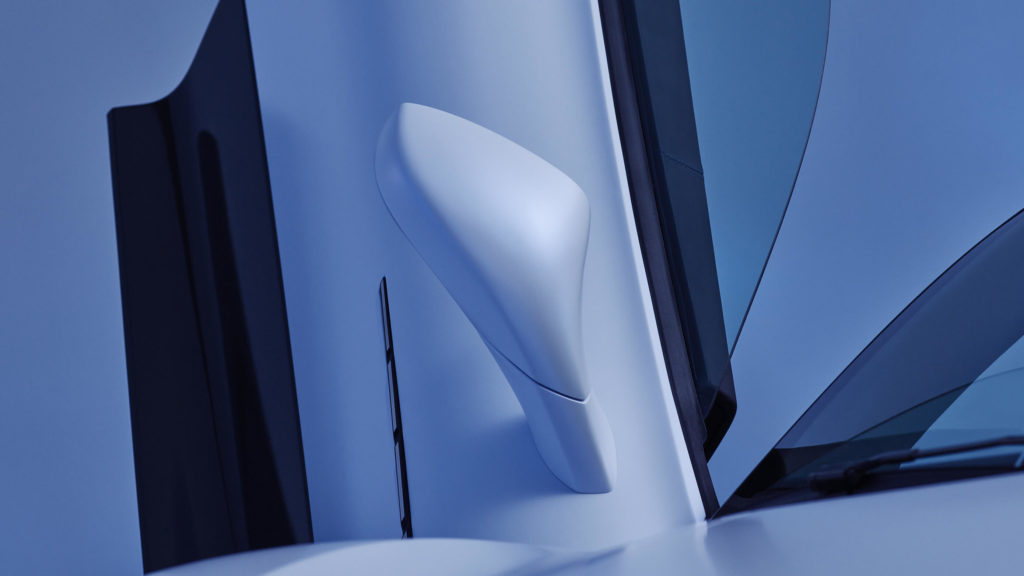Up and until now 3D printing was considered for mass customized parts in which one unique part would fit the driver’s style or body. On supercars and in racing, 3D printing is also used for very low-run production parts number in the dozens. 3D printing is also used in some weight savings parts and extremely low-volume parts on passenger cars. But, generally, in all of these cases, the general wisdom is that larger series automotive components are uneconomical or, at best, low-weight, pricy alternatives to those manufactured by other means.
German research institute Fraunhofer IAPT has radically changed this perception today with a breakthrough 3D printed metal element that is about 50 percent less expensive and 35 percent lighter weight than a milled equivalent.

The 3D printed door hinge. Image courtesy of Fraunhofer IAPT.
Through some radical design methodologies, the IAPT team designed a door hinge component that would normally have been milled. To find the part of choice, the research group used 3D Spark, a parts analysis and screening tool that directs you towards promising parts. They then looked at orientation on the build platform, as well as cost.
“Using the optimized orientation, it was possible, for example, to minimize the number of support structures required while maximizing the number of components that could fit on a build platform. The thus identified component orientation leads to cost savings of 15 percent compared to an additive manufacturing process without such optimization,” Fraunhofer noted.
The component was then designed to take out weight and apply reinforcement only when needed. This cut the overall component weight by 35%. The reduced mass also meant that print time was reduced. That is, material was saved and more could be printed simultaneously. This dropped the costs vis a vis the initial 3D printed part by 20%. The team then further cut mass, machine time, and post-processing by reducing supports, which made the part 10% cheaper still. A new powder was used, lowering the component cost by another 10%.
“Higher layer thickness during printing, optimization of process parameters, and deformation of the laser beam profile significantly reduce build time,” the team noted. “Even though this results in a slight loss of parts quality, (though still superior to that of cast parts), it enables printing costs to be reduced by a further 15%. Optimizing machine utilization by nesting and, if necessary, stacking in the build area, leads to further cost savings of 10%.”
Overall, the new part was 80% cheaper than a straight up 3D printed part that had not been optimized. Of that 80%, 45% of the gain was from supports and orientation, while the rest came from material and process optimization.
Incredibly, the team “was able to show that a cost reduction of additive manufacturing by a factor of five is feasible”, while also improving the look of the component and reducing weight. The part is 50% cheaper than the milled part overall.

The Maserati MC20. Image courtesy of Maserati.
I completely totally love this component. I love that they’ve explained it and how they systematically show us what is being done here. I really believe in low-volume car parts, extending the industry’s ability to offer exotic, mass-customized options. I also believe in mass customized signs, gear knobs, and other visual elements that can give the owner more affect for their car. I also want to see customized seats, headrests, and other 3D printed parts fit to the body. I know we’ll see very obvious 3D printed parts that look cool on cars, as well.
However, cost-effective 3D printed components are a dream. So far, it has been very difficult, but the use of 3D Spark by some bright minds at IAPT has made a very compelling part here. This is breakthrough stuff and shows that there could be many more, really effective components out there if we could just find them. Smart folks and software would seem to be the way to really unlock the value of 3D printing inside large companies.

The Maserati MC20. Image courtesy of Maserati.
IAPT mentions that the part is cost effective for series of 5,000 units, which would mean a very low number of cars. This also illustrated that, for casting, forging, milling, and other processes, there is still a ways to go until we 3D print a main component for a Camry. Depending on if the arms are the same on both sides or if there are two or four of them, it all points to a very low-volume model indeed. Furthest along in 3D printing, are Renault/Alpine F1, Red Bull, the Formula 1 arm of Mercedes, all of the other Formula 1 people, BMW, Porsche, Bugatti, Maserati and Volkswagen, generally, as well as the super mega sports car makers, like Koenigsegg.
Based on the fact that this would be a 2,500 to 5,000 unit run, I was thinking that this might be a part on Maserati’s new MC20. Especially, since the press release talks of the component aiding the “technical performance of the vehicle through lower weight and improved optics.” The MC20 has butterfly doors, which would not only improve mileage but also make the doors easier to open if they were lighter weight. Also engineering firm ABACAD did a project with3D Spark and the firm has traditionally been close to FIAT and Maserati. This is just the type of firm you’d employ to get such a cool door designed. Also check out the wheels on the MC20, just feels like stuff they do. Furthermore, look at the part above. Kind of looks like its meant to go up on something that is not a regular door, right? To me it looks like a hinge for a butterfly door.
Alternatively maybe it’s from the 2022 BMW i8? Anyway, it could be from something much more quotidian, it’s still a milestone part for all of us!
Subscribe to Our Email Newsletter
Stay up-to-date on all the latest news from the 3D printing industry and receive information and offers from third party vendors.
You May Also Like
3D Printing News Briefs, April 13, 2024: Robotics, Orthotics, & Hypersonics
In 3D Printing News Briefs today, we’re focusing first on robotics, as Carnegie Mellon University’s new Robotics Innovation Center will house several community outreach programs, and Ugogo3D is now working...
Rail Giant Alstom Saves $15M with 3D Printing Automation Software 3D Spark
3D Spark has entered into a three-year deal with the rail giant Alstom. Alstom, a transport behemoth with annual revenues of $16 billion, specializes in the manufacture of trains, trams,...
Meltio Expands Global Reach with New Partnerships in the Americas and Europe
Spanish 3D printing manufacturer Meltio has expanded its sales network across the globe. With the addition of three new partners in the United States, Brazil, Argentina, and Italy, Meltio aims...
3D Printing Webinar and Event Roundup: April 7, 2024
Webinars and events in the 3D printing industry are picking back up this week! Sea-Air-Space is coming to Maryland, and SAE International is sponsoring a 3D Systems webinar about 3D...































